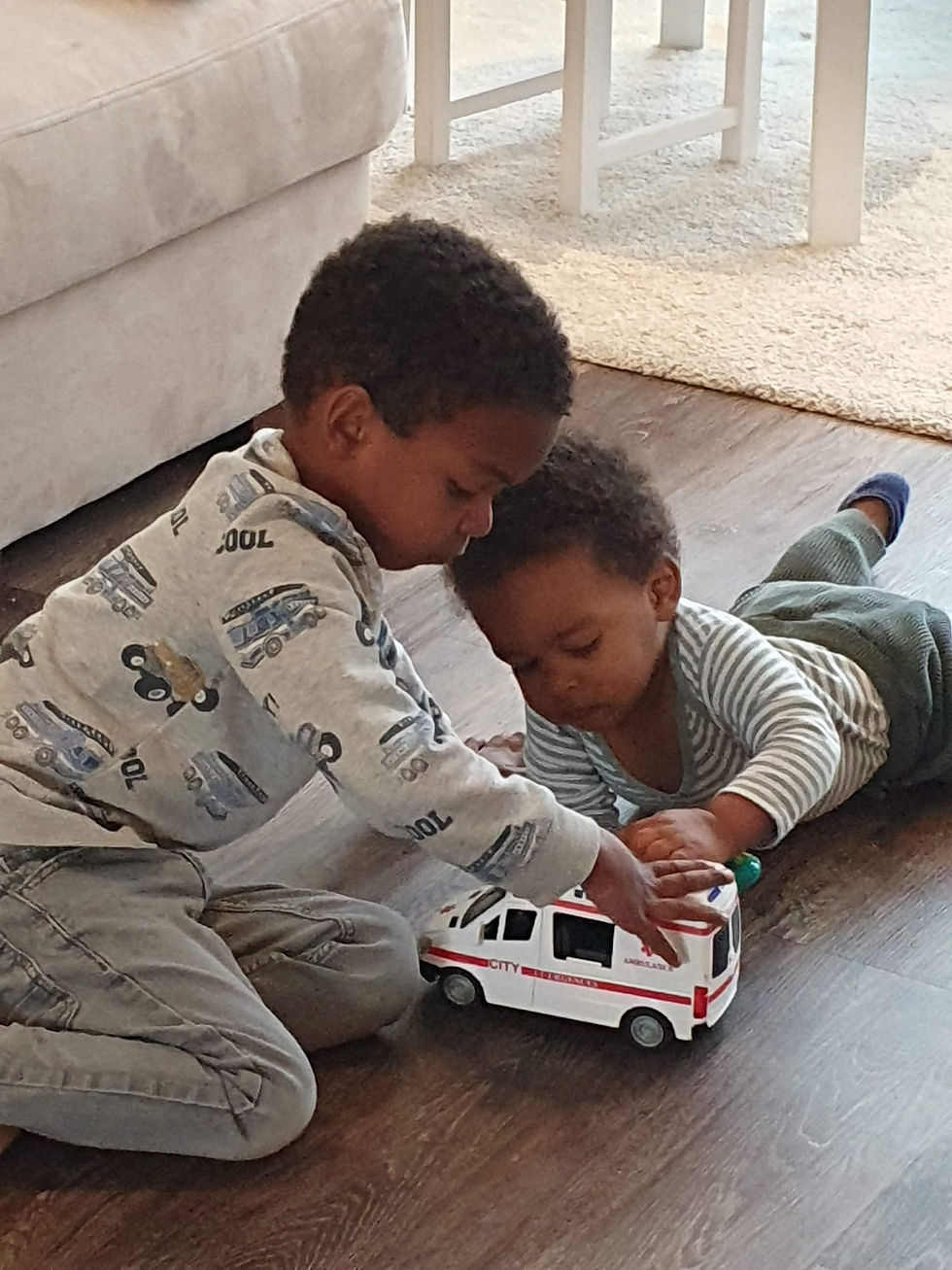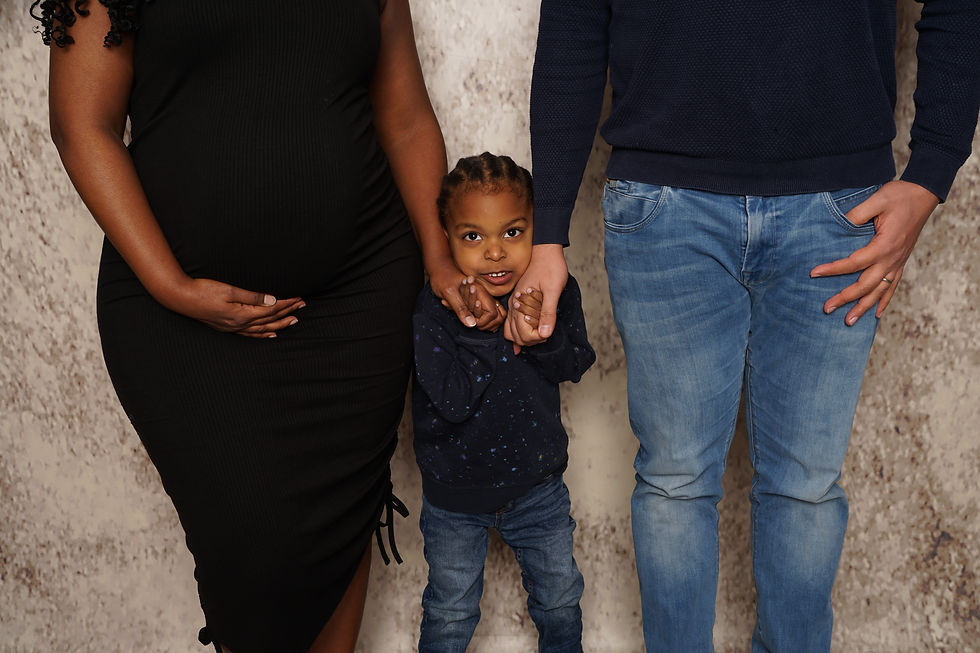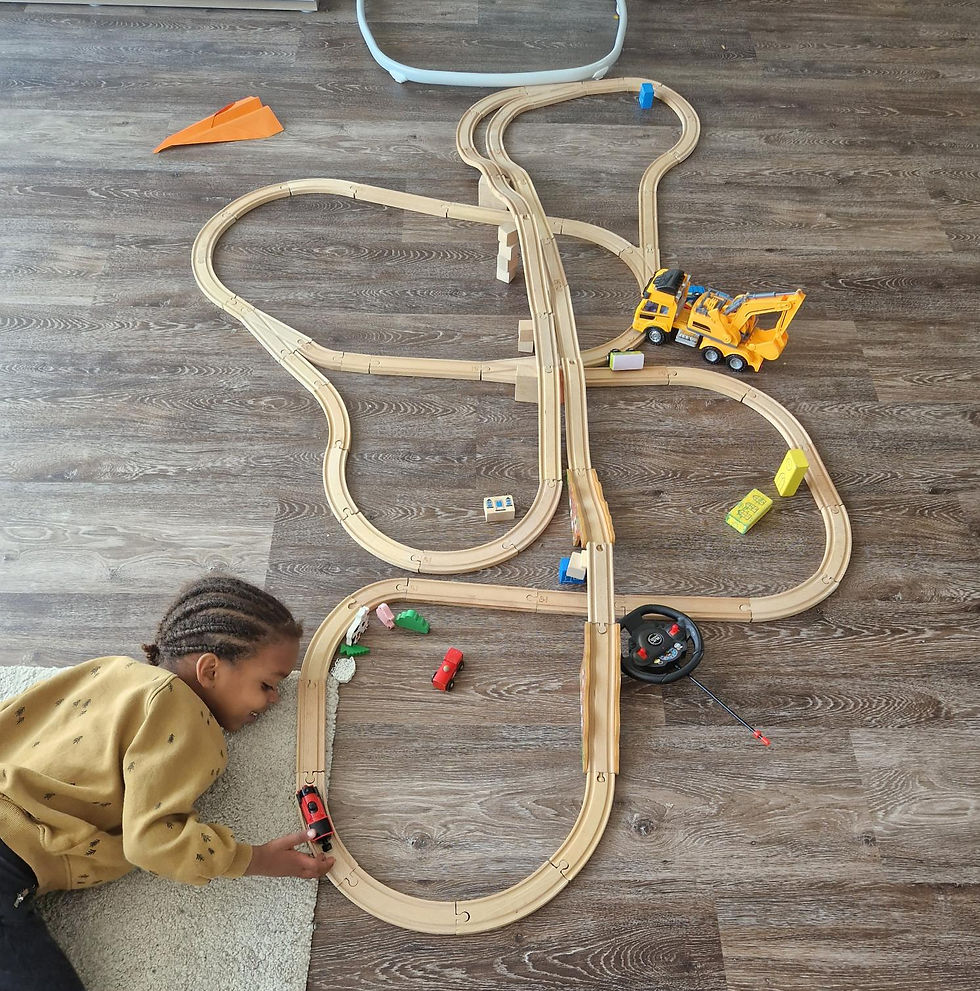Welcoming a new baby into the family is a whirlwind of excitement and emotion, and when one of your children is on the autism spectrum, the experience takes on an additional layer of thoughtful consideration. My husband and I took a deep dive into planning when we decided it was time to expand our family. Our top priority? Ensuring our son Christian, who is autistic, felt comfortable and prepared for his new role as a big brother.
The journey of introducing a new baby to an autistic child can be complex but deeply rewarding. It requires extra doses of patience, understanding, and empathy. But don't worry—we’ve navigated these waters and came out with insights and strategies to share. By embracing careful preparation and empathy, you can guide your children through this exciting transition, fostering a nurturing and positive environment for everyone.

Here are seven strategies that can smooth the way for your family as you embrace this beautiful expansion of siblinghood.
1. Begin the Journey Early
Starting the conversation about a new sibling early on is crucial, especially when you're prepping an autistic child like Christian for such a big change. I found that diving right into this discussion, even if it feels a bit early, really sets the stage for a smoother transition.
Here's how we approached it:
Use Simple, Clear Language: We began with straightforward phrases like, "You're going to be a big brother soon!" This simple language helps plant the seed in a way that's easy for them to grasp.
Involve Them in Prenatal Visits: We brought Christian along to some of the ultrasound scans. He didn't show much interest in the screen—barely glanced at it, really—but I like to think that being there helped him sense that something important was happening. It wasn’t about understanding the images but feeling involved in the journey.
Make Them Part of the Memories: Christian was right there with me for my pregnancy photo shoots. He might not have grasped the full significance, but having him participate made these moments more inclusive and special for both of us.

Incorporate Storytime: We also started reading storybooks about new babies. Titles like “Hello in There!” by Jo Witek are fantastic because they illustrate the new baby concept in a friendly, accessible way. This wasn't just about storytelling; it was a gentle primer to get him used to the idea of family change.
Starting these conversations and activities early really helps in making the entire experience less overwhelming for your autistic child.
2. Preserve the Familiar
For autistic children like Christian, routine isn't just a daily schedule—it's a source of comfort and stability. When introducing a new baby into the family, it's crucial to preserve your child's routine as much as possible to help minimize stress and maintain a sense of normalcy.
Here's how we managed to balance consistency with the inevitable changes a new baby brings:
Integrate, Don’t Overhaul: While we knew some adjustments were necessary, we aimed to integrate the baby’s needs into Christian’s established routines rather than completely overhauling them. For instance, even with the new baby, Christian's bedtime and morning routines stayed the same. This consistency helped him feel secure and unaffected by the changes.
Sync Schedules Thoughtfully: We carefully planned the baby’s feeding and nap times around Christian’s existing schedule. This approach allowed us to maintain Christian's routine of going to bed at the same time every night, which is crucial for him. By aligning the baby's schedule with his, we minimized the disruption to his life.
Create a Dual Routine: Interestingly, this focus on maintaining Christian’s routine also helped us establish a solid routine for the baby. Having a structured plan for the newborn from the start turned out to be beneficial for everyone, making it easier to manage day-to-day activities without overwhelming anyone.
This approach of carefully blending the new baby's needs with Christian's established routines helped us maintain a calm and structured environment. It not only ensured that Christian felt secure during a significant family transition but also facilitated a smoother introduction to sibling dynamics. By keeping his world largely stable, we could support his adjustment to being a big brother without overwhelming him, all while creating a conducive atmosphere for the newborn too.
3. Adjusting routines in advance
Let's be honest , bringing a newborn into the home is a huge tasks and even though we didn't make large changes to Christian's routine. Small adjustments were still needed. In that case, when you know your family dynamics are about to change with the arrival of a new baby, especially for an autistic child, it's wise to start tweaking their schedule ahead of time. This way, any major shifts happen well before the baby arrives, preventing your oldest from associating these changes with the new sibling and possibly developing feelings of resentment.
Here’s how we managed it:
Plan for Postpartum Needs: I was scheduled for a C-section, which meant I'd be on bed rest for a bit. Anticipating that I wouldn't be as available as usual, we began to make gradual adjustments to our daily routines.
Shift Responsibilities Gradually: Knowing that my son was particularly attached to me—truly a mommy’s boy—we started introducing him to new routines where my husband took a more active role. For example, my husband began taking over bath time and our cherished morning play sessions. This wasn't an overnight switch; we eased into it to keep things as smooth as possible for our son.
Increase Bonding Time with Other Family Members: We increased the time our son spent with his dad or grandma, not just in play but also in everyday activities like meals and getting ready for bed. This helped him become more comfortable not having me around every moment, which was crucial for the times I'd be recovering from surgery.
Communicate Through the Changes: Throughout these adjustments, we kept communicating with our son about what was happening and why. For instance, I’d explain, "Daddy is going to help with your bath tonight because Mommy needs to rest a little. It's going to be so much fun!" Reinforcing the positive aspects of these changes made them easier for him to accept.
By making these incremental changes, we helped our son adjust to a new routine without the added pressure of a new baby being right around the corner. By the time the baby arrived, he was already well accustomed to the new schedule, and it made the transition much smoother for everyone involved. This proactive approach not only eased my son into his new reality but also ensured that he didn’t associate the arrival of his sibling with a loss of attention or disruption in his life.
4. Bring a Gift from the Baby: A wonderfully effective way to create a warm and positive first impression between new siblings is to introduce the concept of a gift from the newborn to the older child. This gesture acts as a friendly 'peace offering' and is a fantastic method to spark excitement and foster a feeling of inclusion for your autistic child.
Here’s how we embraced this approach:
Choose Something Meaningful: Select a gift that resonates with your older child's interests. For instance, Christian had a big fascination with building train tracks. So, we decided his new sibling would 'give' him a set of extra train track pieces.
Present It Thoughtfully: When Christian first met his new baby brother, we presented the train tracks with a little story, saying, "Look what the baby brought for you because he can’t wait to be your friend!" This introduction of the baby as someone who already cares and has thought about what Christian likes helped set a tone of friendship and caring right from the start.
Create a Positive Distraction: The new train tracks weren’t just a gift; they became a project that kept Christian engaged and happy during those first, often chaotic, days with a newborn at home. He was so busy and thrilled with his expanded set that it gave him a positive way to channel his energy and excitement.

This strategy can significantly reduce any initial tension that might come with the arrival of a new family member. More importantly, it makes your older child feel special and cherished during a significant change, reinforcing their importance in the family even as dynamics evolve. This thoughtful approach paves the way for a loving sibling relationship that starts on the right note.
5. Offer a Sanctuary
The arrival of a new baby can significantly amplify household noise and activity, which can be overwhelming. Creating a quiet, safe space for your autistic child is not just helpful—it's essential. This personal haven is where they can retreat to find peace and regain a sense of calm when the rest of the house becomes too much.
Here’s how we ensured Christian had his own comforting space:
Identify the Ideal Spot: We noticed early on that Christian would seek out quiet corners to decompress whenever he felt overwhelmed. Recognizing this, we dedicated a specific area just for him. Whether it was a corner of his bedroom or a designated spot in our family play area, we made sure it was tailored to offer tranquility and comfort.
Make it Comforting and Familiar: In these spaces, we included items that Christian finds comforting, like his favorite toys or books, noise-canceling headphones, and his tablet with cartoons he enjoys for distraction. These familiar objects help soothe him and make his safe space feel truly his own.
Ensure Accessibility: We always kept his quiet space readily accessible. There were no barriers to entry—no doors that were too hard to open or clutter that might block his way. This way, whenever he started to feel the need to retreat, he could easily access his sanctuary without any frustration.
Creating this dedicated quiet space helped Christian handle the increase in noise and activity after his sibling's arrival. It provided him with a predictable and serene spot where he could find solace and recharge, making the overall transition to being a big brother much smoother and more positive for him.
6. Encourage Shared Activities
Fostering a strong sibling bond between your autistic child and the new baby can start with shared activities that both can enjoy. These moments of togetherness are crucial, not just for building a connection, but for creating a foundation of mutual affection and understanding that can last a lifetime.
Here's how we encouraged these shared experiences between Christian and his new sibling:
Start with Simple Interactions: We introduced simple activities that didn’t require too much from Christian but allowed him to interact with the baby in a gentle, controlled way. This included talking to the baby during diaper changes or while preparing for naptime, where Christian could feel involved without the interaction being too direct or overwhelming.
Involve in Routine Care: Including Christian in the baby’s routine care activities like bath time or tummy time was a great way for him to feel connected to his new sibling. He would help by passing a towel during bath time or gently playing with a rattle during tummy time. These responsibilities gave him a role in the baby's care, which not only helped in bonding but also in boosting his confidence and sense of importance.
Create Playtime Together: I made a point to integrate the baby into Christian’s playtime. This wasn’t about changing Christian's play to suit the baby, but rather letting the baby be part of the play environment. For instance, if Christian was building with blocks, I would sit with the baby nearby and help Christian show the baby what he was making. This allowed both to be in each other’s company in a relaxed, natural way.
Ensure Positive Associations: Whenever these shared activities took place, I made sure to keep the atmosphere light and positive. I’d express excitement about the baby being part of Christian’s activities and praise Christian for any gentle, kind interactions. This positive reinforcement helped him associate the baby’s presence with happy, enjoyable times.

By including Christian in many of the baby’s activities and vice versa, we nurtured a relationship built on shared experiences right from the start. These moments not only strengthened their bond but also played a crucial role in helping Christian adapt to his new role as a big brother.
7. Patience and Reassurance Are Your Allies
Introducing a new sibling is a monumental shift for any child, and it becomes particularly significant when your child is on the autism spectrum. Handling this transition with patience and continuous reassurance is key to helping them adapt at their own pace.
Here's how we approached this sensitive transition with Christian:
Celebrate Small Victories: Initially, Christian wasn’t very interested in interacting with his new brother, Elijah. However, instead of forcing interactions, we celebrated and praised even the smallest positive moments. When Christian would simply sit next to Elijah or show a momentary interest in his activities, we made sure to express our delight and praise his efforts.
Provide Continuous Reassurance: Throughout this period, reassurance was a constant. We reassured Christian that he was doing great as a big brother and that his efforts, no matter how small, were deeply appreciated. This consistent support helped him feel secure and valued, reducing any potential stress or jealousy.
Observe and Adapt: Over time, Christian’s interest in Elijah grew organically. He began to include Elijah in his activities, and moments like helping find Elijah’s pacifier when he cried or asking him what was wrong became more frequent. These are not just interactions but signs of growing empathy and care, which we encouraged by acknowledging and celebrating them.
Let Bonds Develop Naturally: We learned to be patient and let the relationship develop at its own pace. Forcing a bond can lead to resentment or stress, whereas allowing it to grow naturally can lead to genuine affection and understanding. Watching Christian take initiative in caring for Elijah in his own unique ways was a reward for this patience.

Provide Guidance When Needed: While we let their relationship develop naturally, we also provided gentle guidance to foster understanding. Explaining to Christian how his actions affected Elijah, and vice versa, helped him understand the impact of his behavior and encouraged more positive interactions.
In navigating the introduction of a new sibling, the key is to be patient and provide a nurturing environment that allows the relationship to flourish on its own terms. By supporting each step with positivity and reassurance, you create a family dynamic that encourages compassion and mutual respect among siblings. This patient, supportive approach not only helps your autistic child adapt to the new family setup but also builds a foundation for a strong, loving relationship that will continue to grow over the years.
Remember, every child is unique, and the journey to siblinghood is no different. What works for one child may not suit another, so it’s crucial to tailor these strategies to meet your autistic child’s specific needs. Consulting with a therapist or specialist who understands your child’s unique needs can offer additional personalized strategies and support.
This journey, though filled with challenges, is also replete with opportunities for growth, learning, and immense joy. By approaching this transition with empathy, understanding, and patience, you're not just introducing your child to a sibling—you're nurturing a bond that will enrich your family's life in countless ways.

Comments